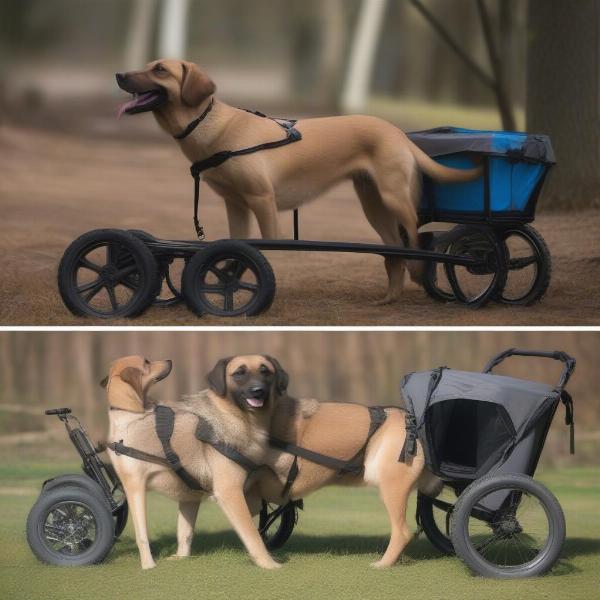A large dog cart can be a lifesaver for senior dogs, those recovering from injuries, or pups with mobility issues. It allows them to still enjoy the outdoors, socialize, and maintain a sense of normalcy. Choosing the right large dog cart involves considering your dog’s size, specific needs, and the terrain you’ll be traversing. Let’s explore the key factors to ensure your furry friend gets the perfect ride.
Factors to Consider When Choosing a Large Dog Cart
Finding the perfect large dog cart requires careful consideration of several important aspects. This includes your dog’s size and weight, their specific needs and mobility limitations, the type of terrain you’ll be using the cart on, and of course, your budget. A well-chosen cart will provide comfort and support for your dog, while also being easy for you to maneuver.
Sizing and Weight Capacity
The most crucial factor is size. Measure your dog’s length (from neck to tail base), height (from the ground to the top of their shoulders), and width (at their widest point). Compare these measurements with the cart’s specifications. Ensure the cart can comfortably accommodate your dog’s weight, and always opt for a cart with a slightly higher weight capacity than your dog’s actual weight.
Dog’s Specific Needs and Condition
Consider your dog’s specific condition. Is it a temporary injury, a chronic illness, or age-related mobility decline? Some carts offer more support and cushioning, ideal for dogs with arthritis or hip dysplasia. Others are designed for more active dogs who need assistance on longer walks.
Terrain and Intended Use
Think about where you’ll be using the cart. Will it be primarily on smooth pavements, or will you be venturing onto rougher trails? Some carts have larger wheels and better suspension for off-road adventures. For city use, a lighter, more compact cart might be preferable. Will your dog be using the cart for short periods or extended outings? This will influence the importance of features like padding and adjustability.
Budget and Features
Large dog carts come in a wide price range. While features like adjustable height, removable supports, and washable liners add to the cost, they can significantly improve your dog’s comfort and the cart’s usability.
Types of Large Dog Carts
There are various types of large dog carts available, each designed to cater to specific needs. Understanding these differences can help you make an informed decision.
Two-Wheeled Carts
These are generally lighter and more maneuverable, suitable for dogs who still have some strength in their front legs. They are often a good choice for shorter walks and paved surfaces.
Four-Wheeled Carts
Four-wheeled carts offer greater stability and support, making them ideal for dogs with more significant mobility challenges. They are also better suited for uneven terrain.
 Two-Wheeled vs Four-Wheeled Dog Carts
Two-Wheeled vs Four-Wheeled Dog Carts
Front Support or Rear Support
Some carts support the dog’s front legs, while others support the rear. This choice depends on which part of your dog’s body requires assistance.
Introducing Your Dog to the Cart
Introducing your dog to their new cart should be a gradual and positive experience. Start by letting them sniff and investigate the cart. Reward them with treats and praise. Then, gradually introduce them to the feeling of being in the cart, starting with short periods and slowly increasing the duration.
Conclusion
Choosing the right large dog cart can significantly improve your dog’s quality of life. By carefully considering factors like size, needs, and intended use, you can ensure your furry friend enjoys comfortable and safe mobility. A large dog cart allows them to continue participating in activities they love, promoting both their physical and mental well-being. Remember to introduce the cart gradually and patiently, creating a positive association for your dog.
FAQ
- How do I measure my dog for a large dog cart? Measure your dog’s length (neck to tail base), height (shoulders to ground), and width (at their widest point).
- What type of cart is best for a dog with arthritis? A four-wheeled cart with good suspension and padding.
- Can I use a large dog cart on uneven terrain? Yes, some carts are designed for off-road use.
- How do I get my dog used to the cart? Gradually introduce them to the cart with positive reinforcement and short sessions.
- Are large dog carts expensive? Prices vary depending on features and brand.
- Where can I buy a large dog cart? Pet supply stores, online retailers, and specialized mobility equipment providers.
- What is the weight limit for a large dog cart? This varies depending on the specific cart model, always check the manufacturer’s specifications.
Related Articles
ILM Dog is a leading international online resource dedicated to providing expert advice and guidance on all aspects of dog care and wellbeing. From breed selection to senior care, nutrition to training, and product reviews to health information, ILM Dog offers practical, reliable information for dog owners worldwide. We are passionate about helping you provide the best possible care for your canine companion. For expert advice, personalized recommendations, or to learn more about our range of services, contact us at [email protected] or call us at +44 20-3965-8624. We’re here to help you and your dog live a happy, healthy life together. Contact ILM Dog today!